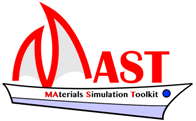8.5. The Recipe section¶
The $recipe section of the input file contains information about how the ingredients are related to each other.
- This information complements the
mast_update_children_methodkeyword given for each ingredient.
An ingredient in the recipe is referred to by:
<ingredient name> (ingredient type in $ingredients section)
For example:
perfect_opt1 (lowmesh_relaxation)
If no ingredient type is given, then only settings from the ingredients_global ingredient type of the input file will be used.
The ingredient name has some restrictions:
For a simple workflow, the ingredient name may be fully and arbitrarily specified for the user.
In most complex workflows, however, tags may be used as shortcuts to ingredient names. These tags will be filled in from information in the input file.
- <S>: The
scalingsubsection of The Structure section- <N>: The Defects section
- <Q>: The
chargekeyword in The Defects section- <P>: The
phononkeyword in The Defects section and 3_1_6_neb- <B>, <E>, <B-E>: The NEB section
- The filled-in tags will be evident in The Personal Recipe section of the
input.inpfile in the recipe directory, once MAST has read the input file and set up the recipe directory.When tags are used, certain conventions must be followed:
Inducing scaling must use an
inducescaling_<S>ingredient.Inducing defects must use an
inducedefect_<N>orinducedefect_<S>_<N>ingredient.Defects must start with
defect, and if tags are used, they must follow the order <S>, <N, B, or E>, <Q>, depending on which tags are used.defect_<S>_<N>_<Q>_arbitrarysuffixPhonons must start with
phonon, and if tags are used, they must follow the order <S>, <N or B-E>, <Q>, <P>NEBs must start with
neb, and if tags are used, they must follow the order <S>, <B-E>, <Q>
Important: when creating or editing recipes, do not use the Tab key. Instead, use 4 spaces to indent.
- See Installation for setting up text editors.
- Also make sure that the recipe you are working with has not somehow been converted to tabs.
8.5.1. Syntax¶
Each indentation level marks a parent-child relationship.:
perfect_opt1 (volrelax_lowmesh)
perfect_opt2
perfect_opt3
The ingredient type of an ingredient is specified in parentheses after the ingredient.
The ingredient type should correspond to ingredient subsections within The Ingredients section. If no ingredient type is specified, the ingredient gets all default values from the ingredients_global subsection.
In the recipe:
perfect_opt1 (volrelax_lowmesh)
In the input file:
$ingredients
begin volrelax_lowmesh
mast_run_method run_singlerun
...
end
$end
If the parent needs to update several children in different ways, create new trees where the originating parent is the same parent name, but with a different ingredient type:
perfect_stat (stat_to_defect)
defect_opt
perfect_stat (stat_to_phonon)
phonon_opt1
- Those different ingredient types should have different mast_update_children_method keyword values in the input file.
- They should have all the same other keywords.
If two children need to be the parent of one ingredient, also create a new tree:
perfect_stat
defect_1_opt
defect_2_opt
defect_1_opt, defect_2_opt
neb_1-2_opt
Parent-child relationships are name-based, and the name must also include correct formats for size-scaling labels <S>, defect labels <N, B, or E>, neb labels <B-E>, charge labels <Q>, and phonon labels <P>.
- These names are important for following the tree structure and for setting the metadata file.
- Parent-child relationships are specified by these particular folder names.
- Some post-processing utilities may also rely on folder names.
The <S> tag
The <S> tag will correspond to labels in the scaling subsection of The Structure section.
The <N>, <B>, <E>, and <B-E> tags For defects, the <N> tag will correspond to labels in The Defects section.
The same labels will be matched up and should be used as <B> and <E> labels (beginning and ending states) to correspond with NEBs, which are labeled <B-E>.
The NEB labels will correspond to labels in The NEB section
NEB label names must match up exactly with defect label names. For example, defect_vac1 and defect_vac2 must match up with neb_vac1-vac2.
Use <N> in a recipe unless specifying that a defect is a parent of an NEB, in which case use <B> or <E>:
{begin}
defect_<N>_opt1 (relax)
defect_<N>_stat (static)
{end}
{begin}
defect_<B>_stat (static_to_neb), defect_<E>_stat (static_to_neb)
neb_<B-E>_opt1 (neb)
{end}
The <Q> tag The <Q> tag will correspond to charges given in The Defects section.
Charges are given as
- q=p0 for no charge
- q=nX for negative charge X (addition of electrons)
- q=pX for positive charge X (removal of electrons)
{begin} and {end}
In the recipe, {begin} and {end} will loop over, match up, and fill in scaling labels <S>, defect labels <N, B, and E>, NEB labels <B-E>, charges <Q>, and phonons <P>
Only charges in the charge range of both the <B> and <E> defect parents of an NEB will produce an charged NEB.
Use a new {begin} and {end} when you have a new tree branch or unindentation in the recipe that switches between <N> and <B> or <E>
Note that defect endpoints need to be the parents of all NEB optimizations and NEB static calculations. Therefore, the endpoint-neb parent-child block may look like the following:
{begin} defect_<B>_stat (static_to_neb), defect_<E>_stat (static_to_neb) neb_<B-E>_opt1 (neb) neb_<B-E>_opt2 (neb) neb_<B-E>_stat (neb_static) neb_<B-E>_opt2 (neb) neb_<B-E>_stat (neb_static) {end}
Full example:
$recipe
perfect_opt1 (lowmesh)
perfect_opt2
perfect_stat (static)
{begin}
inducescaling_<S>
inducedefect_<S>_<N> (inducedefect)
defect_<S>_<N>_<Q>_opt1 (lowmesh_defect)
defect_<S>_<N>_<Q>_opt2 (defect_relax)
defect_<S>_<N>_<Q>_stat (static)
{end}
{begin}
defect_<S>_<N>_<Q>_stat (static)
phonon_<S>_<N>_<Q>_<P> (phonon)
{end}
{begin}
defect_<S>_<B>_<Q>_stat (static_to_neb), defect_<S>_<E>_<Q>_stat (static_to_neb)
neb_<S>_<B-E>_<Q>_opt1 (neb_to_neb)
neb_<S>_<B-E>_<Q>_opt2 (neb_to_nebstat)
neb_<S>_<B-E>_<Q>_stat (nebstat_to_phonon)
neb_<S>_<B-E>_<Q>_opt2 (neb_to_nebstat)
neb_<S>_<B-E>_<Q>_stat (nebstat_to_phonon)
{end}
{begin}
neb_<S>_<B-E>_<Q>_stat (nebstat_to_phonon)
phonon_<S>_<B-E>_<Q>_<P> (phonon)
{end}
$end
